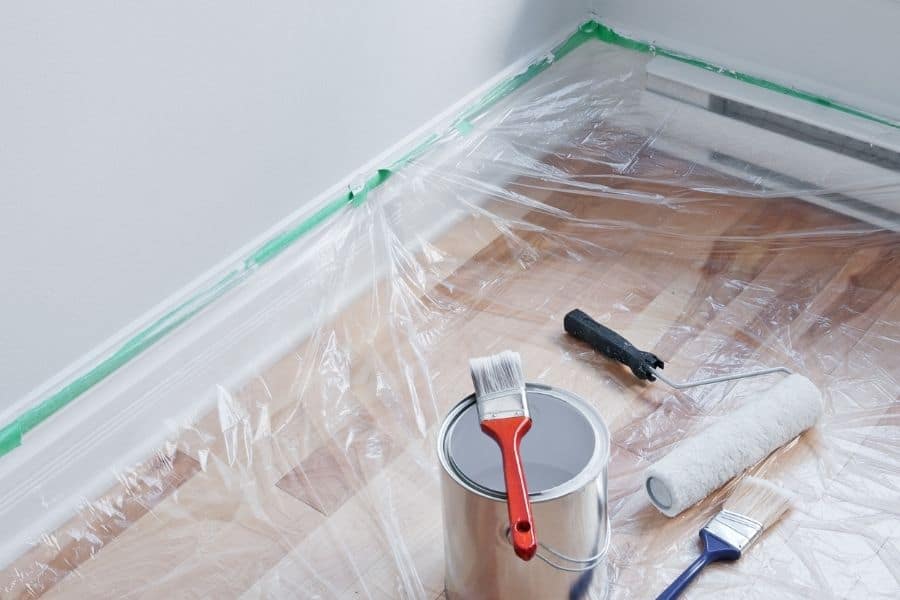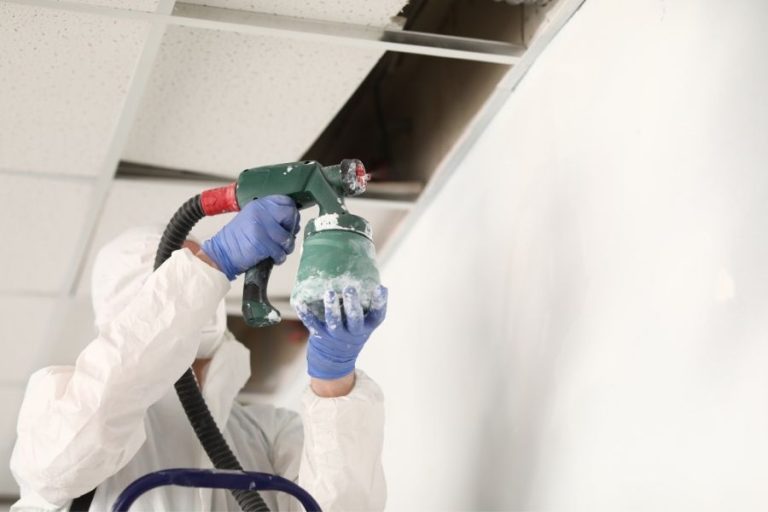Painting high ceilings can be a daunting task, especially if you’re working alone. It requires a lot of planning and preparation. The first thing you need to do is determine how to get to the highest point of the room.
We’ve prepared a step-by-step guide on how to paint high ceilings, so read on to find out!

How to Paint High Ceilings
1. Clear Out the Room
When painting your ceiling, the best way to avoid mess is to get everything out of the room before starting the project. You will then be able to move around freely without having to worry about damaging anything. If you can’t remove the items from the room, try moving them into the center of the room.
2. Cover the Floor

Next, cover the furniture and floors with plastic sheets or drop cloths to prevent any splatter or spillage. Wash the ceiling with a clean rag, warm water, and mild detergent. Allow the ceiling to dry for at least one (1) hour before proceeding to the next step.
3. Choose the Right Paint Colors
If you want to make a room appear bigger, choose a lighter color for the ceiling. If you want to make the room feel smaller, choose a darker color for the ceiling.
You can paint your ceiling using a light or dark shade of the same color as your walls. Or you can use a bright or bolder color to match with the colors used in the decor in your room.
4. Use a Sturdy Ladder or Scaffold
While most paint jobs can be completed using a ladder, a standard 8-foot ladder may not be tall or long enough to reach high ceilings. You should always use a ladder that allows you to easily reach the area you are painting. Never over-extend yourself when reaching to paint. Overextending means you have to stand upon one of the top 3 rungs of the ladder, so if this is happening to you, you will need a taller ladder.
Instead of using a standard ladder, look for platform laddered, articulating laddered or step laddered ones that can reach more than 8 feet. For taller ceilings, you may need an extended ladder. Use a ladder rated for the proper weight limit and job type for the task at hand.
The Little Giant Ladder is simply a very versatile ladder. It can be used as an A-frame, a basic extension ladder, and even split into two smaller ladders if needed. With its lifetime guarantee, there really isn’t another ladder on the market that is more versatile.

If you plan to work at a height for long periods of time, consider using a scaffold. Scaffolds provide a sturdy base to stand while working and keep your tools and paint supplies close at hand. They can be scaled from 5 to 15 feet high. Twenty-foot ceilings can be painted safely using a scaffold.
Ladders are easier to use and move around than scaffolds. They’re also used more frequently around the house, so they might make sense if you plan to do a lot of work on your ceilings or walls. If you choose to use a scaffold, consider renting one instead of buying. Rental yards or home improvement centers do offer scaffolding rentals.
5. Invest in an Airless Paint Sprayer
An airless paint sprayer can be used to spray paint anything you want. It is ideal for painting ceilings, walls, priming drywall, painting exteriors and staining fences. It is also great for the average homeowner, handyman and painter.
For the DIYer, the Graco Magnum X5 sprayer is the perfect entry-level sprayer. It is easy to use, versatile and durable.

You will need a sprayer extension tip to go along with your airless sprayer. It is an elongated metal pole that attaches to your spray gun and will provide you with an extension of typically 12 to 30 inches. These tips are very useful when painting high ceilings. They will allow you to reach further, move your ladder less and
6. Or Use a Paint Roller with Extension Pole
If you do not plan on using a sprayer, then you will need to use a paint roller to paint your ceilings. Attaching an extension pole to the roller frame will also allow you to reach heights otherwise unreachable without a ladder. However, painting a high ceiling while using an extension pole is going to be slow and physically exhausting.
Make sure to get the right-sized pole. Otherwise, you’ll have a very difficult time painting your ceiling! You can get poles in many sizes but for high ceilings, poles ranging between 6-12 feet long would be ideal.
7. Prime and Paint the Ceiling
On a ladder or scaffolding, mask off the area where the wall meets the ceiling. Then, apply a coat of primer. Using an extension pole and roller, extend your reach to prime the entire ceiling. Let the primer dry for 24 hours. Once the primer dries, you can begin to paint in the color you want.
Prepare the paint you need. One gallon of paint should cover 300-400 square feet. Double your measurements for two coats of paint.
Dip the roller into the paint, in the deepest part of the tray. Roll the roller back and forth in the shallower section to remove excess paint. While the roller is covered evenly, start rolling out 6-foot by 6-foot sections on the ceiling.
Start with “W” strokes from right to left. Then use horizontal strokes from left to right. Use less pressure at the edges so you do not create a line when the squares overlap. Continue painting in 6-foot square sections until the entire ceiling is covered.
Touch up any areas missed while the paint is wet. This way you can ensure that you get an even finish. Make sure to roll the brush in the same direction you originally rolled the paint.
When you’re finished, the ceiling should dry within a few hours. Open windows or use a box fan to help to keep the room ventilated while drying.
8. Clean Up
Once the ceiling is fully painted (or repainted), remove the painter’s tape along the edges at a 45-degree angle. This will help keep the new paint from coming off too easily. The longer the painter’s tape stays on the ceiling, the harder it is for you to remove.
Dispose of used paint cans appropriately. Wash your paintbrushes and other equipment thoroughly with warm water and soap. Rinse well until the solvent runs clear. Dry your brushes or rollers in a brush/roller spinner, if you have one. Then store them in their protective sleeves or hang them on nails or hooks for safekeeping.
Do not be in a hurry to remove the plastic sheets or drop cloths and move furniture back into place. Give the paint at least 24 hours to fully dry, so in case the paint drips, it won’t damage your things.
Read also:
How to Get Oil Based Paint Out of Carpet
Wrapping Up
In conclusion, painting your high ceiling is not as difficult as it may seem, and with some patience and practice, you’ll soon have that beautiful new look in no time at all!







